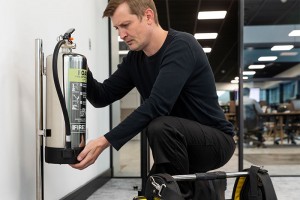Recently added item(s)
You have no items in your basket.

Whilst fire extinguishers have remained similar in design and operation over the years, there are still quite an assortment of tools and spares needed to carry out competent servicing.
Based on the order of checks in BS5306-3 let’s look at what an extinguisher technician’s toolbox should contain:
- Pump tester: For Mija type gauges and can be used on Wika gauges
- Needle tester: For Wika type gauges
- Magnetic tester: For magnetic gauges used by one manufacturer
In addition, cartridge operated extinguishers should have the cartridge removed and weighed using digital scales (battery operated for field use and mains for workshop use) as these are more accurate than a spring balance and can easily be calibrated for continued use.
- Strap wrench: Helps steady the extinguisher to exert enough force to loosen the head, normally used for field disassembly
- Extinguisher clamp/vice: For van or workshop, a fixed clamp is quicker and easier to use
- Spanners: Adjustable or sized in order to remove hoses and horns
- Headcap bars: T-bars in a variety of thread types to fit different makes of extinguisher to remove the valve
- Headcap spanners: C-spanners for specific extinguishers with an external thread and headcap nut
- Rubber mallet: Whilst not the first tool to grab due to the risk of damage to the valve there will occasionally be the need for a tap or two on stubborn to free headcaps
- Flag type tamper tags: The most commonly used type of tamper seal, often used in different colours to indicate year of service
- End cap type tampers: Several brands of extinguishers have a notched pin that can have a cap type tamper fitted (it is not merely a ‘transport’ seal) and some engineers prefer to use these as they are neater and less prone to being accidentally broken
- Chubb OK pins: The Chubb Euro range (1997-2012) uses a plastic safety pin with integral tamper seal (an OK disc) that is broken in two on removal so the whole unit must be replaced. A competent engineer will have a stock of new pins and discs to replace these with, rather than not remove the pin at all or reuse a broken pin with a flag seal
- Chubb FX discs: The Chubb FX range (2012-2017) uses a large reusable clip with a separate OK disc which is broken when the clip is removed – again a competent engineer will stock the OK discs
- Universal OK pin: A thinner version of the Chubb OK pin that fits most standard makes of extinguisher
- Firechief Pull Safe Pin: An alternative to standard pins this device is easy to grip and remove and won’t jam if the user is accidentally putting pressure on the top level, unlike standard pins.
- Replacement steel pins: Sometimes an extinguisher has had the pin removed or been lost, so a stock of varied sizes should be held.
- Corrective Action Required labels: Required by BS5306-3 for extinguishers where the required service has not been completed, e.g., an Extended Service
- Condemned labels: Required for extinguishers deemed obsolete or unsafe for use
- Discharge horn labels: A handy extra to indicate if a swivel horn is safe to hold or unsafe to hold
- Low freeze labels: To indicate where an extinguisher is filled with low freeze additive which needs replacing on refilling
- Verified alternative labels: Required by BS5306-9 where an extinguisher has been filled with a compatible, but not OEM, refill charge
Fire Depot has been the UK's favourite fire safety supplier for over 50 years, we know the fire protection and prevention business inside out. Our experienced team can offer advice and guidance about any of our fire safety products. For expert help and advice, please contact the Fire Depot team on 0330 999 2233, email us at sales@firedepot.co.ukor visit https://www.firedepot.co.uk/ to see our full range of fire safety products.
The information contained within this blog is provided solely for general informational and educational purposes and is not intended as a substitute for professional advice. Before taking any actions based upon this information, we advise the reader to consult any and all relevant statutory or regulatory guidance and where felt necessary to consult a qualified fire or industry regulation professional. The use or reliance on any information contained herein is solely at the reader’s risk.